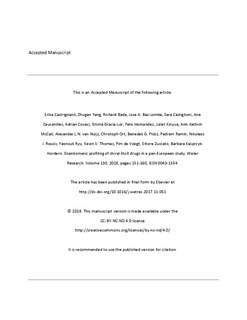| dc.contributor.author | Castrignanò, Erika | |
| dc.contributor.author | Yang, Zhugen | |
| dc.contributor.author | Bade, Richard | |
| dc.contributor.author | Baz-Lomba, Jose A | |
| dc.contributor.author | Castiglioni, Sara | |
| dc.contributor.author | Causanilles, Ana | |
| dc.contributor.author | Covaci, Adrian | |
| dc.contributor.author | Gracia-Lor, Emma | |
| dc.contributor.author | Hernandez, Félix | |
| dc.contributor.author | Kinyua, Juliet | |
| dc.contributor.author | McCall, Ann-Kathrin | |
| dc.contributor.author | van Nuijs, Alexander L N | |
| dc.contributor.author | Ort, Christoph | |
| dc.contributor.author | Plosz, Benedek G | |
| dc.contributor.author | Ramin, Pedram | |
| dc.contributor.author | Rousis, Nikolaos I | |
| dc.contributor.author | Ryu, Yeonsuk | |
| dc.contributor.author | Thomas, Kevin V | |
| dc.contributor.author | de Voogt, Pim | |
| dc.contributor.author | Zuccato, Ettore | |
| dc.contributor.author | Kasprzyk-Hordern, Barbara | |
| dc.date.accessioned | 2019-06-03T08:34:38Z | |
| dc.date.available | 2019-06-03T08:34:38Z | |
| dc.date.created | 2019-03-19T13:58:16Z | |
| dc.date.issued | 2018 | |
| dc.identifier.citation | Water Research. 2018, 130, 151-160. | nb_NO |
| dc.identifier.issn | 0043-1354 | |
| dc.identifier.uri | http://hdl.handle.net/11250/2599639 | |
| dc.description | Embargo until 01 December 2019 | nb_NO |
| dc.description.abstract | The aim of this paper is to present the first study on spatial and temporal variation in the enantiomeric profile of chiral drugs in eight European cities. Wastewater-based epidemiology (WBE) and enantioselective analysis were combined to evaluate trends in illicit drug use in the context of their consumption vs direct disposal as well as their synthetic production routes. Spatial variations in amphetamine loads were observed with higher use in Northern European cities. Enantioselective analysis showed a general enrichment of amphetamine with the R-(−)-enantiomer in wastewater indicating its abuse. High loads of racemic methamphetamine were detected in Oslo (EF = 0.49 ± 0.02). This is in contrast to other European cities where S-(+)-methamphetamine was the predominant enantiomer. This indicates different methods of methamphetamine synthesis and/or trafficking routes in Oslo, compared with the other cities tested. An enrichment of MDMA with the R-(−)-enantiomer was observed in European wastewaters indicating MDMA consumption rather than disposal of unused drug. MDA's chiral signature indicated its enrichment with the S-(+)-enantiomer, which confirms its origin from MDMA metabolism in humans. HMMA was also detected at quantifiable concentrations in wastewater and was found to be a suitable biomarker for MDMA consumption. Mephedrone was only detected in wastewater from the United Kingdom with population-normalised loads up to 47.7 mg 1000 people−1 day−1. The enrichment of mephedrone in the R-(+)-enantiomer in wastewater suggests stereoselective metabolism in humans, hence consumption, rather than direct disposal of the drug. The investigation of drug precursors, such as ephedrine, showed that their presence was reasonably ascribed to their medical use. | nb_NO |
| dc.language.iso | eng | nb_NO |
| dc.publisher | Elsevier | nb_NO |
| dc.rights | Attribution-NonCommercial-NoDerivatives 4.0 Internasjonal | * |
| dc.rights.uri | http://creativecommons.org/licenses/by-nc-nd/4.0/deed.no | * |
| dc.title | Enantiomeric profiling of chiral illicit drugs in a pan-European study | nb_NO |
| dc.type | Journal article | nb_NO |
| dc.type | Peer reviewed | nb_NO |
| dc.description.version | acceptedVersion | nb_NO |
| dc.rights.holder | © 2018 Elsevier | nb_NO |
| dc.source.pagenumber | 151-160 | nb_NO |
| dc.source.volume | 130 | nb_NO |
| dc.source.journal | Water Research | nb_NO |
| dc.identifier.doi | 10.1016/j.watres.2017.11.051 | |
| dc.identifier.cristin | 1685946 | |
| dc.relation.project | EC/FP7/317205 | nb_NO |
| cristin.unitcode | 7464,30,21,0 | |
| cristin.unitcode | 7464,20,13,0 | |
| cristin.unitname | Miljøkjemi | |
| cristin.unitname | Økotoksikologi | |
| cristin.ispublished | true | |
| cristin.fulltext | postprint | |
| cristin.qualitycode | 2 | |

